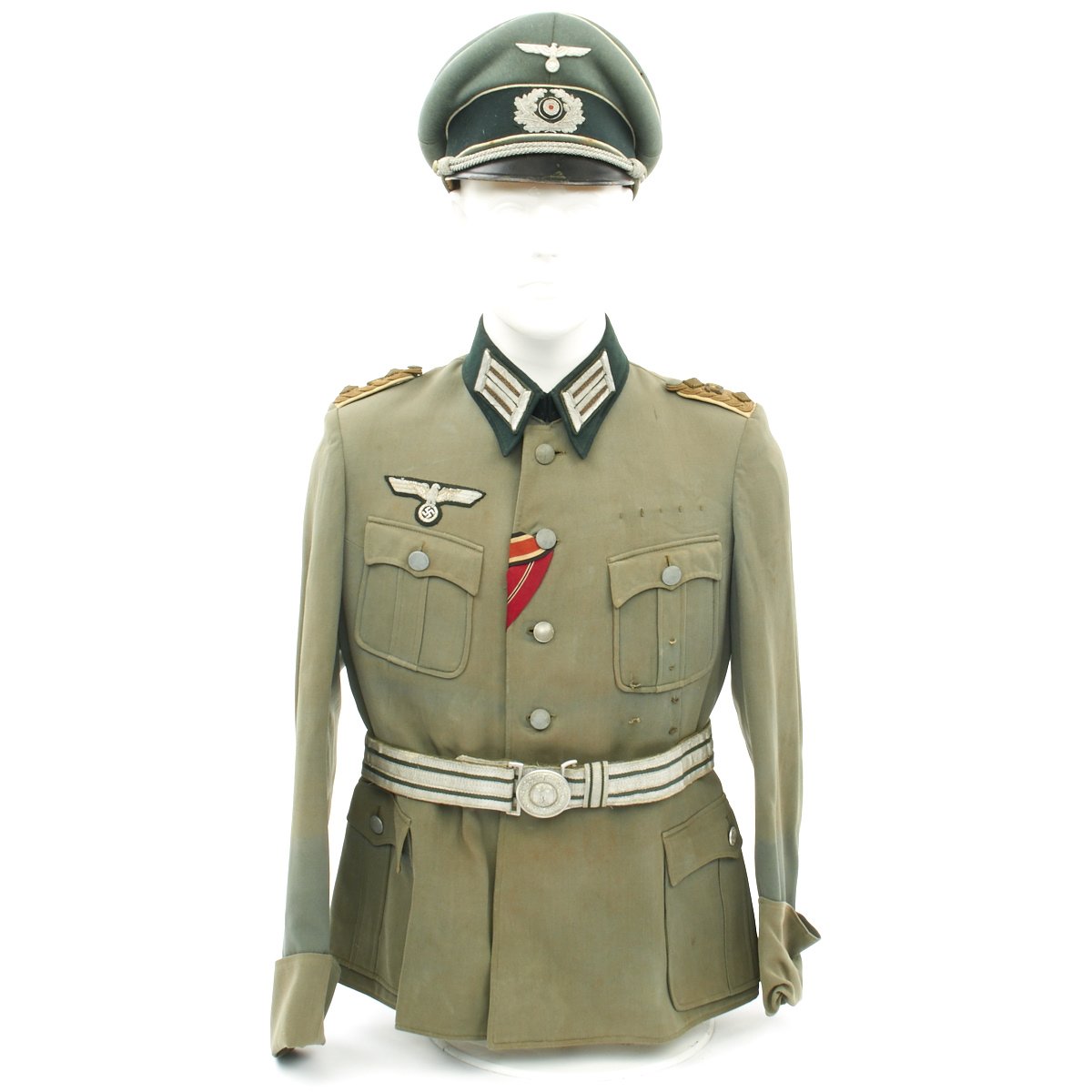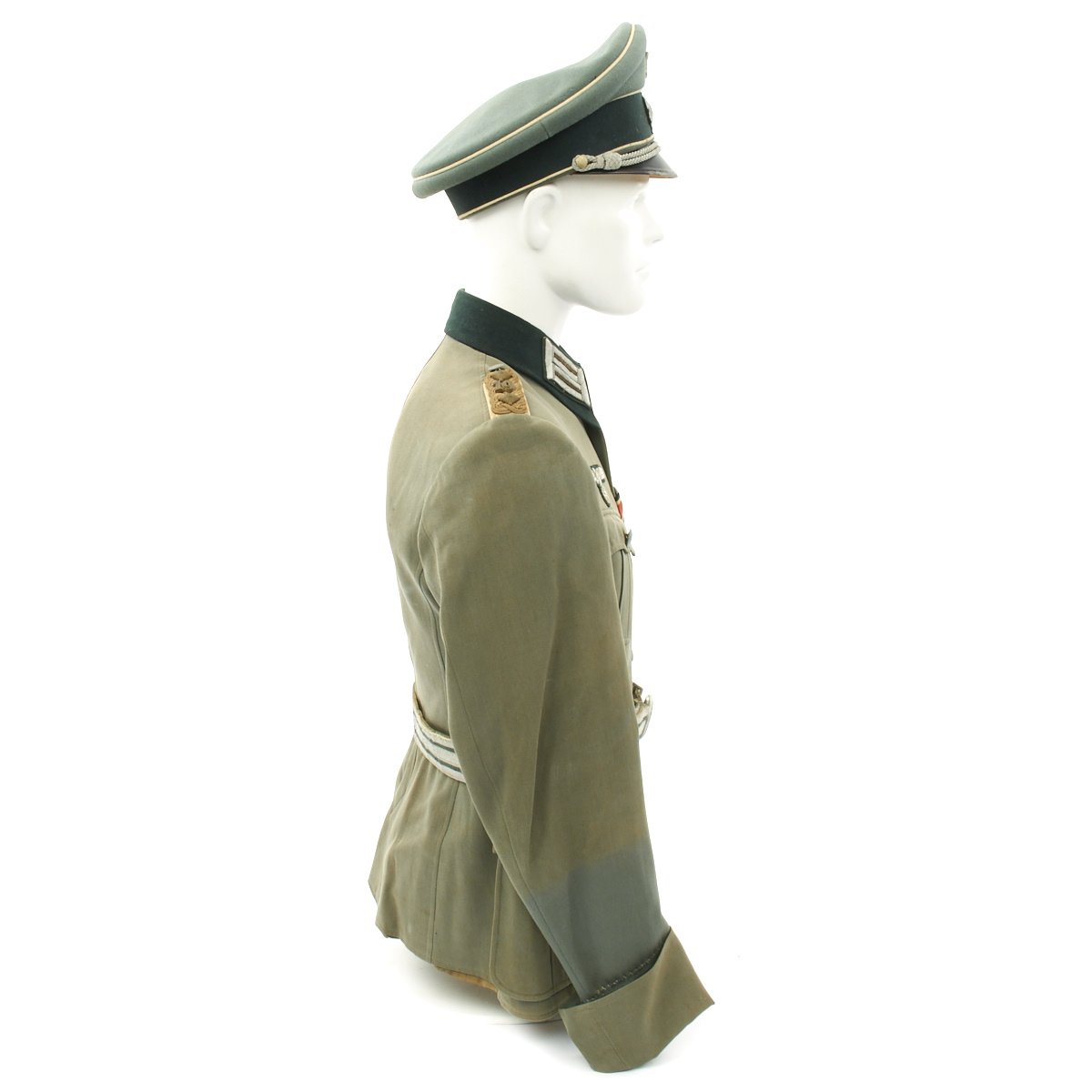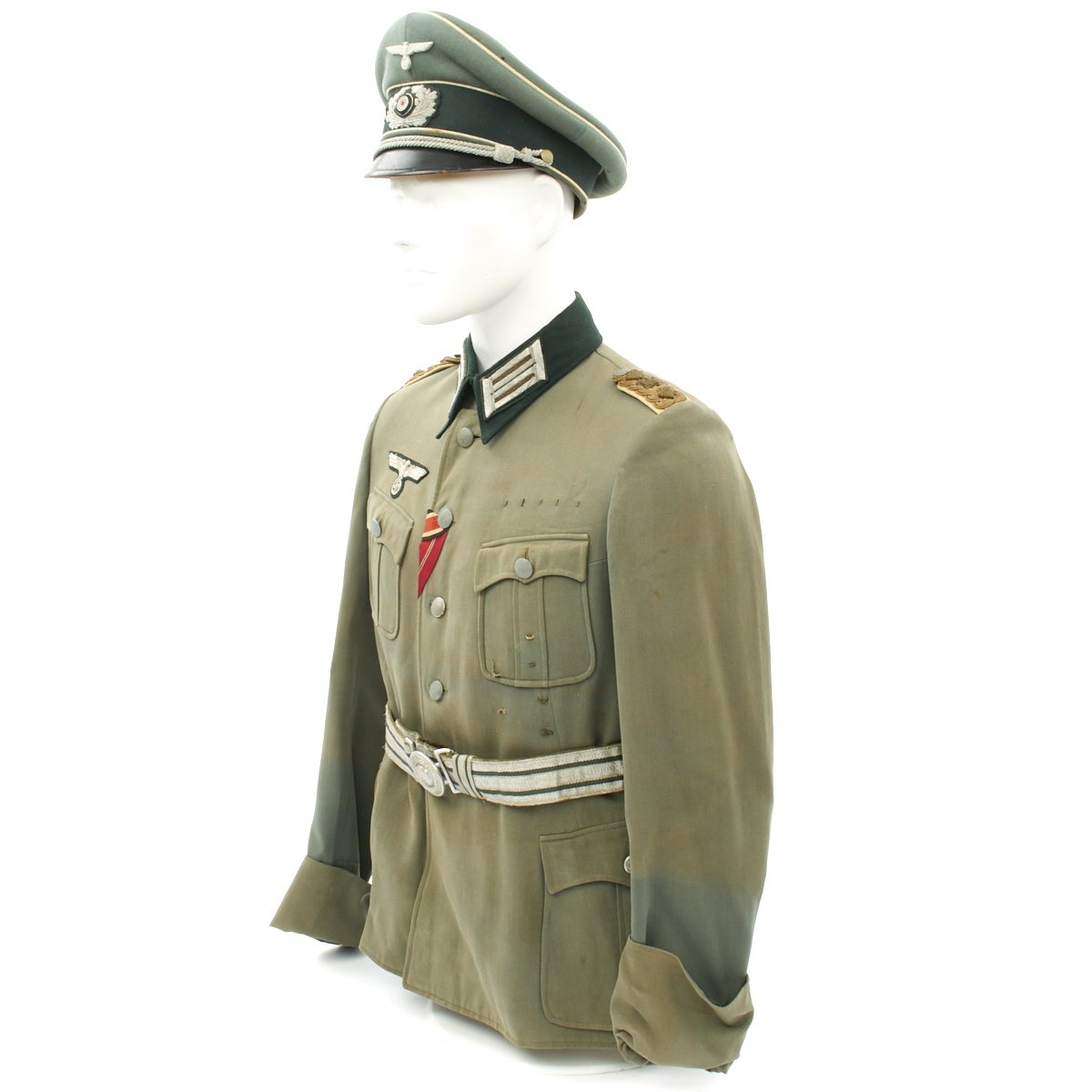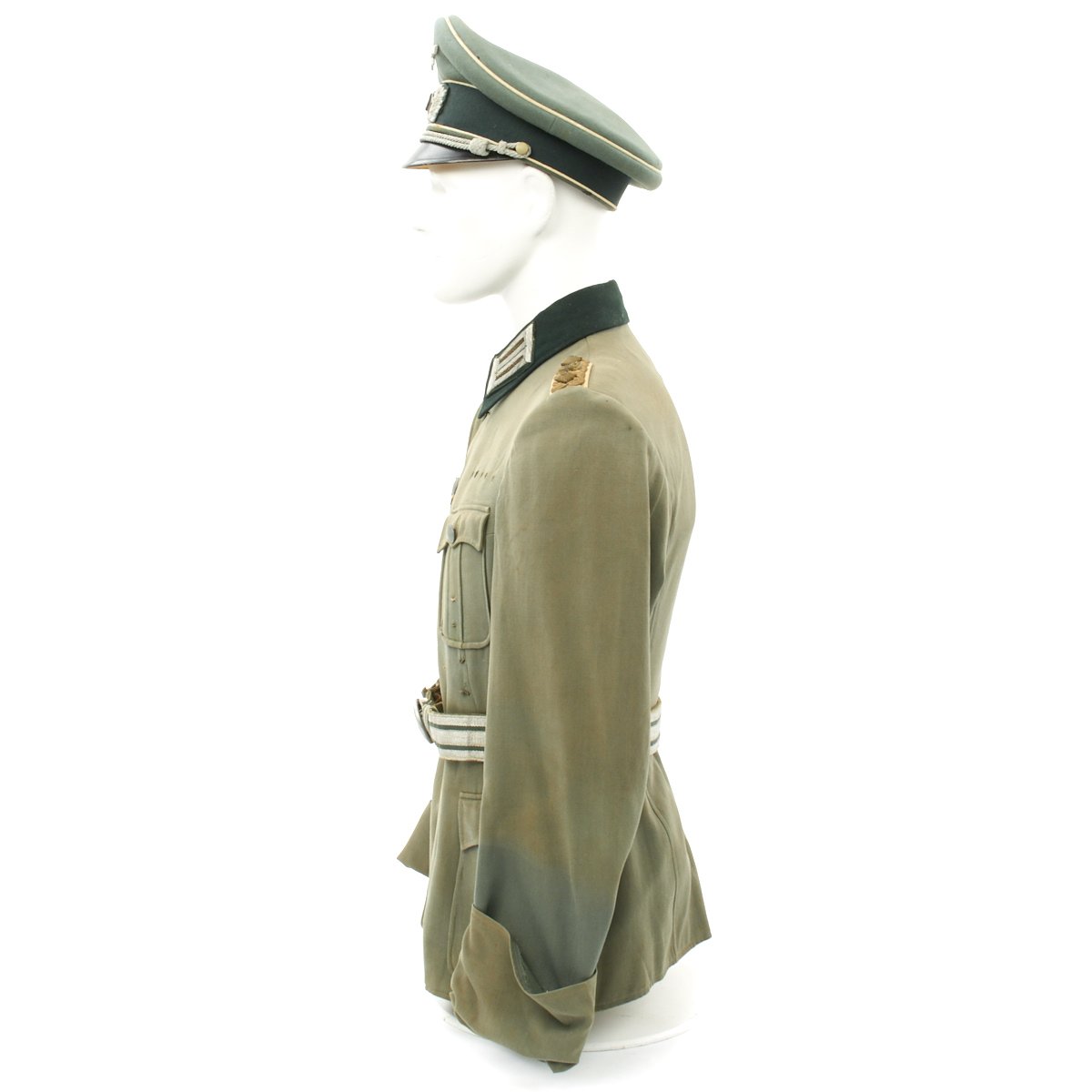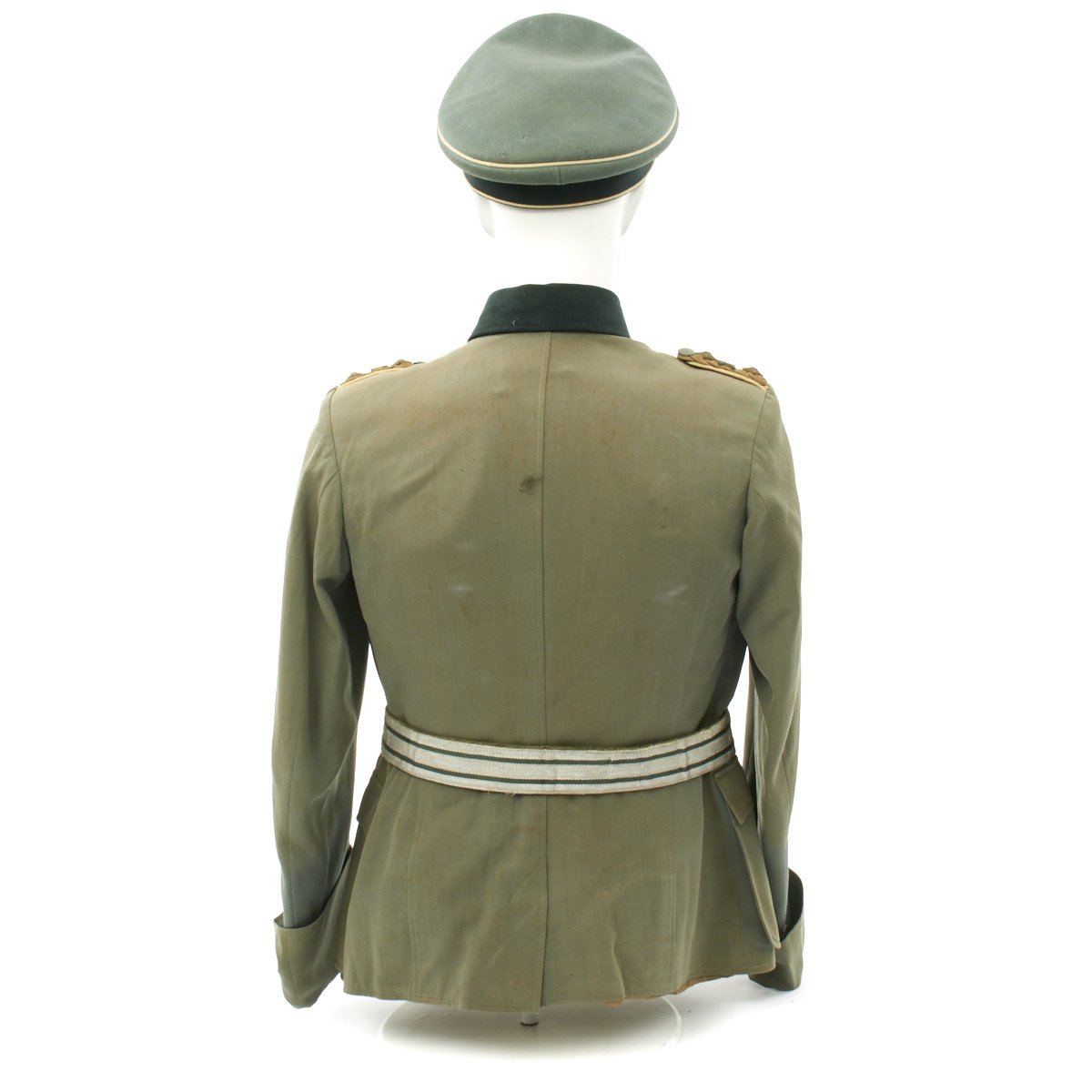Original German WWII Army Colonel Tailored Uniform – Tunic, Belt, Visor Cap by Erel Original Items
$ 2.995,00 $ 748,75
Original Item: One-of-a-kind. This is an absolutely gorgeous, choice example of a tailor made WW2 German Army Oberst (Colonel) officer tunic. Officers had to supply their own uniforms, and they were usually obtained from private tailors, as is the case here. This beautiful tunic is untouched, and in excellent overall condition. The tunic itself is made of a light weight field gray/green wool. The front closes with five silver painted buttons. The attractive Army breast eagle is hand embroidered in aluminum bullion, and is very neatly hand stitched to the chest in a fashion typical of wartime German tailor work. The collar tabs are green piped, and are machine applied; there is no sign of previous tabs ever having been applied.
The officer shoulder boards each have a two gold colored rank pips, indicating the rank of Oberst (Colonel), and are neatly and tightly applied. In between the pips brass gold colored number 19 which we believes indicates the 19th infantry. There are tailor applied loops for multiple badges and for a ribbon bars.
The exterior of this officer tunic is clean, retaining virtually all of the original wool nap, and showing only minor staining and some fading. The cuffs which are folded up are loose.
The inside of this Army officer tunic is fully lined with artificial silk, as is typical, and exhibits lots of neatly done hand sewing. The interior of the M36 style dark green badge cloth collar has clips for affixing a celluloid collar bind. There is a machine embroidered tailor tag in the lining indicating manufacture by the firm of Kahn Napnau of Munchen (Munich). The inner pocket bears a Kahn Napnau of Munchen label which is named ? Otto Frank and dated 4.4.40. This tunic makes for a fantastic display.
Also included are
– Classic Heer Officers Brocade Buckle and Belt. These brocade belts were worn as part of the regalia of German Army officers, for formal occasions. This one has bright silver finish that is very nearly 100 percent intact. This Aluminum constructed Heer Officers Brocade Buckle features a German Army eagle and swas emblem surrounded by a wreath of oak leaves. It’s a great strike, with fine detail, and a striking design. The rear of the buckle has great original finish, and is maker marked for Assman. The original keeper with prongs for affixing this to the brocade belt is intact, functional, and perfect, with no issues. One will easily encounter 100 enlisted Heer buckles for every one of these officer brocade buckles and belts. The belt is on very good condition with a bit of wear to the leather adjustment area. The inside in lined in green velvet.
– Original German WWII Army Heer Officer Visor Cap by EREL. This is a very nice condition EREL Officer’s Schirmmütze Visor Cap. This is a very high quality manufactured visor. Fabricated in Army green gray wool, with wide dark green wool cap band, plus three rows of white wool piping around the circumference. The peak visor cap retains early-quality, oak leaves, along with cockade and a red felt center above which is a and aluminum eagle with swas hat badge. The cap is lined with deep golden-yellow silk and shows a full-celluloid diamond bearing the Erel trademark (faded). It reads:
Size of this cap is approximately 58cm. This is a very nice, Erel Heeres-Kleiderkasse Officer peak visor cap offered for sale in excellent condition with a beautiful saddle-form shape.
Overall what a Uniform set! A fantastic tunic, belt and visor cap ready to make a fantastic display.
The Heer, the army of the German military during the Third Reich, was established in 1935. Over the next 10 years, German Army troops wore a huge variety of uniforms. Enlisted men generally wore uniforms issued from military depots. Most enlisted soldiers wore wool trousers and a tunic with four external pockets, known as a Feldbluse (field blouse). Before the war, soldiers also were issued a walking-out tunic, with flashy insignia, called the Waffenrock. Officers wore the same general uniform styles, but as officers had to supply their own uniforms, they usually wore tailor made versions. There were also myriad varieties of specialized uniforms worn by certain units or in specific situations, from the stylish black wool “wraps” worn by crews of armored fighting vehicles, to the drab HBT work uniforms. There were tropical and summer uniforms, and camouflage smocks for combat troops. For troops operating in winter climates, there were long wool overcoats, fur clothing articles, and padded jacket and trousers sets. In 1944, a new uniform was introduced, featuring a short jacket with only two external pockets. Most but not all German Army uniform jackets bore the Heer emblem of an eagle holding a swas.
Fast Shipping with Professional Packaging
Thanks to our longstanding association with UPS FedEx DHL, and other major international carriers, we are able to provide a range of shipping options. Our warehouse staff is expertly trained and will wrap your products according to our exact and precise specifications. Prior to shipping, your goods will be thoroughly examined and securely secured. We ship to thousands clients each day across multiple countries. This shows how we're dedicated to be the largest retailer on the internet. Warehouses and distribution centres can be located throughout Europe as well as the USA.
Note: Orders with more than one item will be assigned a processing date depending on the item.
Before shipping before shipping, we'll conduct a thorough inspection of the items you have ordered. Today, the majority of orders will be delivered within 48 hours. The delivery time will be between 3-7 days.
Returns
The stock is dynamic and we cannot completely manage it because multiple stakeholders are involved, including our factory and warehouse. So the actual stock may alter at any time. It's possible that you may not receive your order once the order has been made.
Our policy is valid for a period of 30 days. If you don't receive the product within 30 days, we are not able to issue a refund or an exchange.
You can only return an item if it is unused and in the same state as the day you received it. You must have the item in its original packaging.
Related products
Uncategorized
Armored Burgonet Helmet & Polearm from Scottish Castle Leith Hall Circa 1700 Original Items
Uncategorized
Uncategorized
Uncategorized
Uncategorized
Uncategorized
Band of Brothers ORIGINAL GERMAN WWII Le. F.H. 18 10.5cm ARTILLERY PIECE Original Items
Uncategorized
Uncategorized
Uncategorized
Uncategorized
Uncategorized
Uncategorized
Uncategorized
Uncategorized
Uncategorized
Uncategorized
